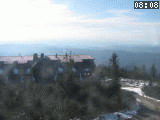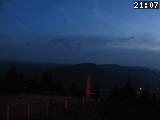Lysá hora 1323 m n. m. - královna Moravskoslezských Beskyd
Saturday 24. May 2025
History of Jablunkov town [ History ]
According to the claims of historians, the beginnings of old Jablunkov probably lie in the place where Hrádek village is situated today. There, in the middle of wild brushwoods, unspoiled forests and pinewoods, the Těšín Princes founded a warning castle site guarding the southwest border of the Principality. The first settlers settled around this castle site and in this way they founded a new village, now called Jablunkov. It probably happened in the 12th century.
The first well-documented reference to Jablunkov comes from 1435. Jablunkov was completely destroyed by the Hungarians in around 1447. After this event, a part of Jablunkov's population probably moved to the place where the Lomná River flows into the Olše River, and they started the construction of the new Jablunkov there. In a document from 1523 dealing with an obligatory purchase of Těšín beer, there are references to Jablunkov and Old Jablunkov.
On May 6, 1560 the Těšín Prince Václav II bestowed on Jablunkov important urban privileges (wine taproom, brewing rights, cattle grazing, regular Tuesday market, annual election of the Village Mayor (or so called "Fojt"), mill construction, etc.). The town developed and it had its Mayor and municipal council by the end of the 16th century /1596/.
The position of Jablunkov was the main factor in its development. Jablunkov lay on an ancient merchant path with its beginning at the Mediterranean Sea, that led through southern Europe to the Jablunkov Pass, from here to the Odra river and further on to Szczecin (Stettin) as far as the Baltic coast. This road was founded by the merchants of Ancient Rome, which is evidenced by frequent findings of coins from this era here. This path was also called the Copper Path, because its utilization of wagons with copper ore coming from the Mediterranean Thurzov-Fugerov mines and journeying as far as Wroclaw. Also of great importance was the merchant road going through Jablunkov to Galician. Passing Istebná, it was situated in the direction of Živec, continuing further to Cracow. Jablunkov became the resting place of many merchant caravans. Many townsmen took advantage of the fact and started to pursue their trade. Jablunkov became better known, which is reflected in the richness of its market and fairs. Population both from near and distance surroundings visited them. Advantageous conditions for the development of handicrafts originated simultaneously.
There were 42 town houses in Jablunkov in the first half of the 17th century. These were wooden cottages and two-storey houses in the square and two-storey houses and ground level houses in the vicinity of the main streets. Jablunkov with its suburbs and together with Písečná had 750 citizens in the late 1740s. Jablunkov citizens pursued trading, handicrafts and above all, the farming of fields in the 18th century. They sowed corn, beans, runner beans and peas. No less important was cattle breeding.
The number of new buildings rose in Jablunkov, and in 1905, a new town hall was completed. In the same year, a new steel bridge with riveted structure came into use. (The bridge survived until the 1970s). A new law court building was consecrated on New Year's Day 1911. Besides that, there was a spacious new prison built surrounded by a thick high wall.
The map of the former Europe changed after the end of World War I. Czechoslovakia and Poland got involved in an argument about Těšín Silesia at the definition of their boundaries. The Czech side argued that this area had belonged to the Czech Crown before the break-up of the Czech State at the beginning of the 17th century and that is why the Czechoslovak Republic had an inalienable right to it. The Polish side responded demanding the division of Těšín Silesia on the ethnic principle. This meant the annexation of an area settled by the population of the Polish origin speaking Polish language or Polish dialect. One such an area lay in the Jablunkov region.
On October 7, 1920 Minister Beneš and Polish Prime Minister Grabski signed a declaration enabling the handing over of an authorization for defining the boundary in the Těšín region to the Allied Highest Council without any referendum. The Highest Council handed over the authorization to the Council of Ambassadors and they ruled on the division of the Těšín Region on July 28,1920. The western part of the Těšín Region together with the whole Jablunkov Law District (with the exception of the villages Javořinka and Istebná) received Czechoslovakia. The boundary in Těšín was formed by the Olše River and so the old historical part of the town on the Polandavý bank of the Olše River feel to Poland and the new part of the town incl. the railway track was connected to Czechoslovakia.
The first well-documented reference to Jablunkov comes from 1435. Jablunkov was completely destroyed by the Hungarians in around 1447. After this event, a part of Jablunkov's population probably moved to the place where the Lomná River flows into the Olše River, and they started the construction of the new Jablunkov there. In a document from 1523 dealing with an obligatory purchase of Těšín beer, there are references to Jablunkov and Old Jablunkov.
On May 6, 1560 the Těšín Prince Václav II bestowed on Jablunkov important urban privileges (wine taproom, brewing rights, cattle grazing, regular Tuesday market, annual election of the Village Mayor (or so called "Fojt"), mill construction, etc.). The town developed and it had its Mayor and municipal council by the end of the 16th century /1596/.
The position of Jablunkov was the main factor in its development. Jablunkov lay on an ancient merchant path with its beginning at the Mediterranean Sea, that led through southern Europe to the Jablunkov Pass, from here to the Odra river and further on to Szczecin (Stettin) as far as the Baltic coast. This road was founded by the merchants of Ancient Rome, which is evidenced by frequent findings of coins from this era here. This path was also called the Copper Path, because its utilization of wagons with copper ore coming from the Mediterranean Thurzov-Fugerov mines and journeying as far as Wroclaw. Also of great importance was the merchant road going through Jablunkov to Galician. Passing Istebná, it was situated in the direction of Živec, continuing further to Cracow. Jablunkov became the resting place of many merchant caravans. Many townsmen took advantage of the fact and started to pursue their trade. Jablunkov became better known, which is reflected in the richness of its market and fairs. Population both from near and distance surroundings visited them. Advantageous conditions for the development of handicrafts originated simultaneously.
There were 42 town houses in Jablunkov in the first half of the 17th century. These were wooden cottages and two-storey houses in the square and two-storey houses and ground level houses in the vicinity of the main streets. Jablunkov with its suburbs and together with Písečná had 750 citizens in the late 1740s. Jablunkov citizens pursued trading, handicrafts and above all, the farming of fields in the 18th century. They sowed corn, beans, runner beans and peas. No less important was cattle breeding.
The number of new buildings rose in Jablunkov, and in 1905, a new town hall was completed. In the same year, a new steel bridge with riveted structure came into use. (The bridge survived until the 1970s). A new law court building was consecrated on New Year's Day 1911. Besides that, there was a spacious new prison built surrounded by a thick high wall.
The map of the former Europe changed after the end of World War I. Czechoslovakia and Poland got involved in an argument about Těšín Silesia at the definition of their boundaries. The Czech side argued that this area had belonged to the Czech Crown before the break-up of the Czech State at the beginning of the 17th century and that is why the Czechoslovak Republic had an inalienable right to it. The Polish side responded demanding the division of Těšín Silesia on the ethnic principle. This meant the annexation of an area settled by the population of the Polish origin speaking Polish language or Polish dialect. One such an area lay in the Jablunkov region.
On October 7, 1920 Minister Beneš and Polish Prime Minister Grabski signed a declaration enabling the handing over of an authorization for defining the boundary in the Těšín region to the Allied Highest Council without any referendum. The Highest Council handed over the authorization to the Council of Ambassadors and they ruled on the division of the Těšín Region on July 28,1920. The western part of the Těšín Region together with the whole Jablunkov Law District (with the exception of the villages Javořinka and Istebná) received Czechoslovakia. The boundary in Těšín was formed by the Olše River and so the old historical part of the town on the Polandavý bank of the Olše River feel to Poland and the new part of the town incl. the railway track was connected to Czechoslovakia.
LOCATION
- Village or Town/City: Jablunkov
- District of Administration 2: Jablunkov
- District of Administration 3: Jablunkov
- Region NUTS 4: Okres Frýdek-Místek
- Region NUTS 3: Moravskoslezský kraj
- Region NUTS 2: Moravsko-Slezsko
- Tourist region: 38 Beskydy - Valašsko
- Destination: Severní Morava a Slezsko
INFORMATION: http://www.jablunkov.cz
Type: History
LAST MODIFY: Eliška Černochová (Beskydy-Valašsko) org. 56, 09.03.2010 v 08:49 hodin



